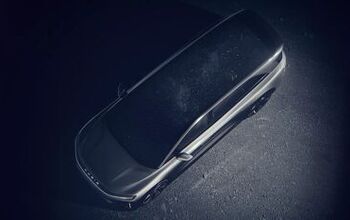Lincoln to Offer Three Flavors of Corsair

It’s nice to write about a vehicle with an honest-to-goodness name, especially one that replaces a vehicle with an alphanumeric name. As it slowly relegates past three-letter combinations to the dustbin of history, Lincoln Motor Company is busy putting the finishing touches on the next product in its utility vehicle offensive: the Corsair, formerly the MKC.
The smallest vehicle in Lincoln’s renewed stable, the Corsair debuts for the 2020 model year. While the model’s new name is meant to conjure up images of a small sailing boat, most will associate it with a brawny WWII American warbird. This, if it needs to be said, is not a bad thing.
A 2020 model year VIN decoder document sent from Ford to the National Highway Traffic Safety Administration spells out your powertrain options. Interested in a plug-in hybrid?
You’ll be able to choose one, as the document shows what we’ve seen suggested in spy photos. In addition to two purely internal combustion offerings, Ford’s 2.5-liter four-cylinder will mate with an electric motor beneath the Corsair’s hood, generating a power figure that remains TBD. The 2.5L iVCT engine makes 175 hp and 175 lb-ft of torque in a base Fusion S. Driving range of this plug-in hybrid is again anyone’s guess, but Ford’s Fusion Energi plug-in saw an upgrade to 25 miles for 2019.
As middling range, combined with a higher sticker price, is not a strong selling point, Lincoln is no doubt under some pressure to offer a CUV that goes the distance, and for not too much of a markup. Note that the PHEV model is only offered with all-wheel drive.
The remainder of the engine options should look familiar, as they’re carried over from the MKC. Entry level power comes from a 2.0-liter Ecoboost four-cylinder rated at 237 net brake horsepower, with tonier buyers sure to spring for the 2.3-liter version. That one is listed at 275 net brake hp. The VIN doc lists front-and all-wheel drive models in base or Signature trim.
One thing that should disappear for 2020 is the MKC’s outdated six-speed automatic transmission.
While we haven’t seen one sans camo, it’s clear Lincoln designers want to endow the little CUV with Aviator-esque styling. Exactly when we’ll see this crossover debut is another mystery, though this fall seems likely — perhaps at the L.A. Auto Show.
[Images: Brian Williams/Spiedbilde]

More by Steph Willems
Latest Car Reviews
Read moreLatest Product Reviews
Read moreRecent Comments
- SCE to AUX Range only matters if you need more of it - just like towing capacity in trucks.I have a short-range EV and still manage to put 1000 miles/month on it, because the car is perfectly suited to my use case.There is no such thing as one-size-fits all with vehicles.
- Doug brockman There will be many many people living in apartments without dedicated charging facilities in future who will need personal vehicles to get to work and school and for whom mass transit will be an annoying inconvenience
- Jeff Self driving cars are not ready for prime time.
- Lichtronamo Watch as the non-us based automakers shift more production to Mexico in the future.
- 28-Cars-Later " Electrek recently dug around in Tesla’s online parts catalog and found that the windshield costs a whopping $1,900 to replace.To be fair, that’s around what a Mercedes S-Class or Rivian windshield costs, but the Tesla’s glass is unique because of its shape. It’s also worth noting that most insurance plans have glass replacement options that can make the repair a low- or zero-cost issue. "Now I understand why my insurance is so high despite no claims for years and about 7,500 annual miles between three cars.



































Comments
Join the conversation
Let's see now.....will it be the Lexux UX, or this thing.....decisions, decisions...
I will wait for the new Lincoln Corsair to arrive before deciding on a new car purchase. I like the look of the Aviator but it might be to big for my needs. Gas power version for me too. The Nautilus will not be redesigned until 2021 for 2022?